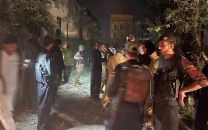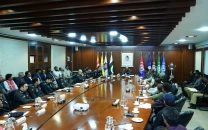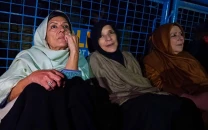Education in Pakistan: 64 years of complacency
We are bound to have a major catastrophe on our hands.

In spite of the constant mushrooming of private schools in every nook and corner of Lahore, the overwhelming majority of children in the city actually go to public schools. Most of them drop out by the time they reach fifth grade. Given that quality primary education actually yields the highest socio-economic return to the population, this is especially tragic.
Pakistan is on the verge of a youth bulge in its population, with more than 50 per cent of the population in Pakistan under 20 years of age. When these young individuals enter the job market without an education or the necessary skills for gainful employment, we are bound to have a major catastrophe on our hands.
Public schools are in dire straits: they have crumbling infrastructure untrained teachers and inadequate resources and thus cannot meet even the most basic needs of the children. What has the government done about it?
Well, the government employs an army of officials working with a creaky system to transform the failing education system. Every primary and middle public school in Lahore is tightly-controlled by officials of the Education Department working from a decrepit building on Hall Road.
The government annually assigns funds to each primary school for maintenance and repair and other small-scale projects — play grounds, furniture, etc. — to deal with the crumbling infrastructure. The other source of funds for a school is the tuition fee — a meagre Rs20 — collected from the students every month, which is spent on paying utility bills and stationery items.
The head teacher of every school is responsible for maintaining these accounts on raggedy registers. The school is also supervised by the school council — a committee comprising the head teachers, a few parents and members of the local community. The school council has been set up to sanction the utilisation of the funds dispersed by the government. To ensure the correct distribution of funds, the Auditor General’s Office sends its auditors to the schools.
Even though it might seem fine in principle, the system is highly anachronistic and has been working like this for the past 64 years, with some minor changes introduced by previous governments in their vain attempts to reform the system.
In reality, though, the Education Department is over-staffed, corrupt, and inefficient; its behemoth bureaucracy prevents imparting quality education in our public schools.
After spending a year touring the schools and the education department and talking to the people pulling all the levers, here’s how I view the system.
The head teachers of nearly all the primary schools I have visited spend more time making rounds of the offices of the District Officers — their immediate supervisors — than actually teaching any classes. Other teachers are left to their own devices; those who are punctual firmly believe in using severe forms of corporal punishment to keep their students in line and rarely ever adhere to their job description.
In most schools, the school council rarely ever meets. In case of repair work, the head teacher has to write letters to the education department, which is already piled ceiling-high with files.
Further still, the head teacher is supervised by a long hierarchy of officials at the education department, beginning with the assistant education officers and ending with the executive district officer. Each of these officials is also assigned a legion of secretarial staff, whose job is to fetch tea, push files and occasionally become a victim of public scolding from their government officials so that they may appear more authoritative in front of visitors.
The school council funds are roughly Rs35,000 a year, and head teachers typically have to bribe the local official in the education department to have the funds released. In the rare instance that the head teacher is actually audited, he/she can, in turn, just pay the auditors to have everything cleared. Most of the infrastructure rehabilitation work is carried out through dubious contracts between the head teachers and local contractors. And so the problematic system rolls along.
There are, of course, some anomalous cases of head teachers who actually use the funds to have their schools refurbished. With the elections around the corner, the government has coughed up more funds this year compared to those allocated in preceding years. New officials have been appointed, who have taken it upon themselves to reform the system — even if it involves building playrooms to be used strictly for ‘display’ purposes during official visits. Other than that, all I have witnessed is that the additional funds have been typically used to spruce up head teachers’ offices, instead of being used for much needed repairs.
On the academic side, things haven’t changed, and probably will not for a long time to come simply because the teachers’ union won’t allow it. They’d rather whine and protest and throw their support behind political leaders who vow to demand the least of them. I was particularly struck by the condescending tenor in which teachers explain why their students don’t perform well — “they’re beggars’ children, what do you expect?” is what one of the teachers had to say about underperforming students.
Life magazine has some black and white pictures of Lahore’s public schools on its website, which date back to the time just after partition. Sadly enough, if you were to take black and white pictures of the schools today and juxtapose them to the ones by Life magazine, you won’t be able to tell them apart.
Published in The Express Tribune, August 27th, 2011.



















COMMENTS
Comments are moderated and generally will be posted if they are on-topic and not abusive.
For more information, please see our Comments FAQ